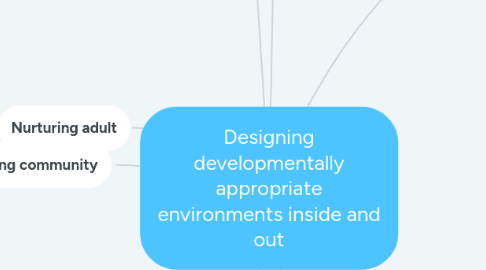Designing developmentally appropriate environments inside and out
by Ashley Sadler


1. Environment
1.1. Sees
1.2. Hears
1.3. Touches
1.4. Tastes
2. Nurturing adult
2.1. Positive attitude
2.2. High expectations for all the children
2.3. Skills to help children learn
2.4. Make sure. Classroom,activities, and materials are ready
2.5. Creative and flexible
2.6. Warm and personal interactions
2.7. Give children a sense of belonging
2.8. Show respect to children and parents
2.9. Tolerant and forgiving of mistakes
2.10. Willing to admit own mistakes
2.11. Compassion for others
2.12. Fair, impartial, and unbiased
2.13. Maintain good sense of humor
3. Learning community
3.1. Every child has a responsibility and role to play. They all share similar educational principles, work towards common goals, their activities are linked and as a grouped they create a energy that contributes to each other’s learning.
4. Traffic patterns
4.1. Routes children take as they move around the classroom
5. Calm, peaceful classroom atmosphere
5.1. Skills for democracy
5.1.1. Essential skills
5.1.1.1. Communicative,
5.1.1.2. Able to listen
5.1.1.3. Collaborative
5.1.1.4. Flexible problem solver/ decision makers
5.1.2. Essential qualities
5.1.2.1. Respectful
5.1.2.2. Responsible
5.1.2.3. Altruistic
5.1.2.4. Able to see others perspectives
6. Indoor
6.1. Arrange shelves and furniture to clearly identify learning centers
6.2. Make children’s traffic so they don’t interrupt each other
6.3. Make it so teachers can observe the whole classroom without obstruction
6.4. Use materials that appeal to the senses, encourage movement, and reflect diverse life experiences
6.5. Begin simple add more as the children learn to understand the ground rules: be safe, be responsible, be respectful
6.6. Consider the different abilities of every child
6.7. Display materials T eye level of children
6.8. Space materials out so they aren’t on top of each other
6.9. Put learning materials in buckets or baskets
6.10. Color code, label, or use pictures so children can put toys away on their own
6.11. Separate noisy materials from quiet ones
6.12. Place learning centers near the resources needed such as garbage, water, drying rack
6.13. Have a variety of materials
6.14. Change environment to reflect child’s interests and abilities routinely
7. Outdoor
7.1. Age appropriate
7.2. Zones for play-grassy running zone, climbing equipment zone, sand and water play, tricycle riding zones
7.3. Open sight so that teachers can see children in all areas at all times
7.4. Trees, grass, and other vegetation
7.5. Movement opportunities such as running, climbing, crawling, sliding, and balancing
7.6. Safety surfaces around all fall zones
7.7. Manipulative area for sand and water or objects to be moved, carried, or rearranged
7.8. Shady areas where children can lean on structures or sit on/in
7.9. Areas that offer a feeling of privacy
7.10. Natural colors and textures
7.11. Raised gardening boxes
7.12. Accessible
8. Routine and consistency
8.1. Schedules
8.2. Child directed play
8.3. Teacher directed play
8.4. Transition
8.4.1. Time where a child leaves one activity to another
8.4.1.1. Calm transitions
8.4.1.1.1. Give notice “ 5 minutes till cleanup “
8.4.1.1.2. Assure transitions are predictable and timely
8.4.1.1.3. Following a routine
8.4.1.1.4. Keep unrushed and peaceful
8.4.1.1.5. Eliminate waiting time
8.4.1.1.6. Add physical components for fun and engagement
8.4.1.1.7. Plan and rephrase difficult transitions
8.4.1.1.8. Consider individual needs

